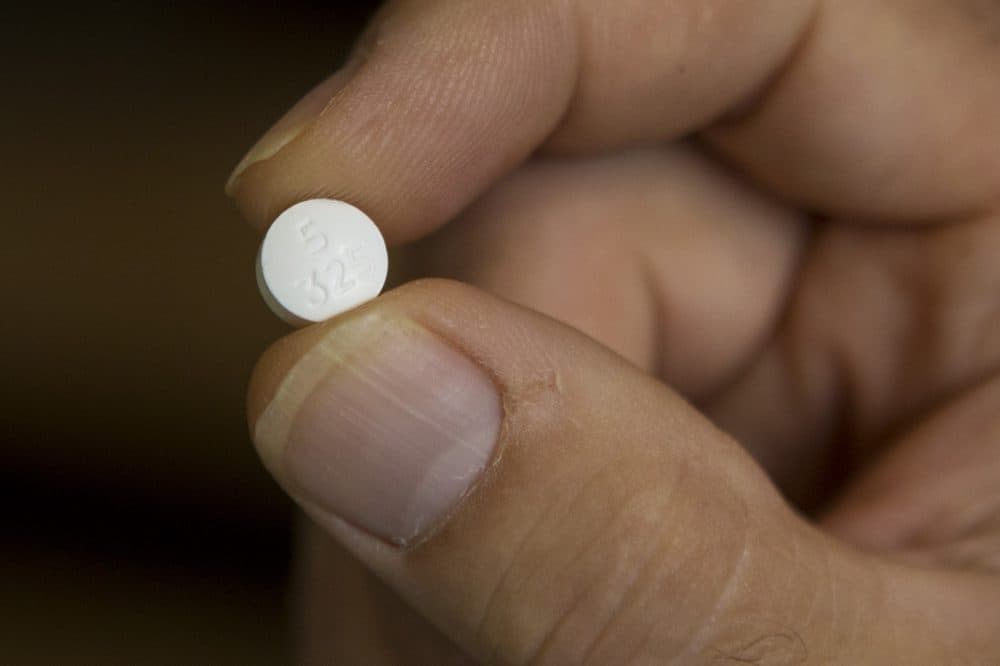Advertisement
Opioid-Era Parenting Diary: A Fraught Week With Oxycodone In Our House

WBUR State House reporter Steve Brown shares the dread and dilemmas that a once-simple painkiller prescription creates for a parent in this time of high concern about opioid addiction.
Tuesday, Aug. 9, 1 p.m.
I just got back from the pharmacy with 14 oxycodone pills and I am very concerned about what the next 48 hours may bring. I hope I’m overreacting, and just being extra cautious, but I’m wrestling with my decision to make the purchase for my 18-year-old daughter.
Just four hours ago, I drove her to her oral surgeon in Brockton to have her four impacted wisdom teeth removed. They'd been bothering her for a while, and the X-rays made it pretty obvious they had to go.
The procedure itself is pretty common. It seems nearly everybody has had it done (not me, I’m chicken). But it is the aftercare that has me worried. There have been countless stories lately of well-adjusted honor students who fall victim to the scourge of opiate abuse after being given a prescription much like the one that was handed to me as my daughter was groggily coming out of the effects of anesthesia.
While I have no reason to think my daughter would become addicted, my thought has been, Why take the chance? Still, no parent wants to see their child in pain, and the doctor cautioned us that the worst pain would come on the second and third day after the surgery.
I asked the doctor whether, given all the recent news stories of opiate abuse, there might be an alternative to the drug he prescribed: He called it Percocet, but the label says oxycodone. I even inquired whether something like Tylenol with codeine might be a good replacement, though that is an opiate as well. He said that would not be effective in this case.
The nurse handed me the prescription for the 14 pills and the doctor said I could choose not to fill it if I desired, or ask the pharmacist to supply a lesser number, as is allowed by the new state opiate law that was signed into law by Gov. Charlie Baker earlier this year.
The doctor urged me to fill the prescription and have it on hand, should my daughter’s pain intensify, as it likely will once all the Novocaine wears off. He suggested starting her on the pain meds today, so the pain doesn’t hit her all at once and will be manageable.
I realize the oxycodone is an effective drug when used properly, and if we need to break it out, we'll use it sparingly. Still, I’m hopeful my daughter will have a high pain threshold once the discomfort ramps up, and the oxycodone can remain hidden away through the weekend, when I can get the damned things out of my house and hand them over to the local police department for disposal.
In addition to the oxycodone, my daughter was prescribed ibuprofen 600 mg and amoxicillin 500 mg. The ibuprofen is a non-addictive painkiller that’s nowhere near as powerful as the oxycodone. The amoxicillin is to prevent infection.
Wednesday, Aug. 10, 3 p.m.
I was a bit more hopeful earlier today that the Percocet will remain unused. My daughter woke up this morning swollen, but not terribly in pain. She took one of the ibuprofens last night at around 6. I told her she could have another at midnight, if she thought she needed it. She fell asleep before midnight, and stayed asleep until 3 a.m., when she got up to get an ice pack, and took an ibuprofen. She took another at 9 a.m.
About an hour ago, I got the following text: “My right bottom is really bothering me right now. I’m trying to wait till 3. But that one is the one that hurts the most.”
I texted back that she should try to ice it up, which she did, and then she took a nap. I found out she was sleeping when I called and woke her up, to let her know it was 3, and she could have the ibuprofen now.
I have explained to her my concern over the Percocet, and she sees my point, and is willing to work through the pain. I’m still uncertain the path her pain will be taking over the next 48 hours. Will it intensify? Will the ibuprofen continue to provide her enough relief to leave the Percocet stash untouched?
Thursday, Aug. 11, 4 p.m.
I’m breathing a bit easier today, thinking my daughter will recover from her extractions with minimal discomfort, meaning the Percocet will stay unused. She’s been getting by with just the ibuprofen 600 mg. Depending on her sleep schedule, she’s been able to expand the length of time between ibuprofens to roughly nine hours; she’s at the prescribed six-hour intervals when she’s awake. Her biggest concern has been not pain but the swelling. It should peak today before subsiding, from what I have read.
I have mixed feelings about the Percocet still hidden in the back of my sock drawer. I know for some people it has been the passageway to a downward spiral of addiction. But for others, it can provide needed acute pain relief. The tough part is not knowing how it would affect my daughter, were she to need it, and that’s what prompted me to want to hold off giving it to her.
Now, more than 48 hours after her surgery, I’m thinking she won’t need it, and for that I’m grateful. She’s spending this afternoon with her boyfriend, swollen cheeks and all, so she must be feeling pretty good.
Friday, Aug. 12, 9 p.m.
The swelling has gone down, but my daughter is still experiencing some pain, particularly in her lower right jaw. That seems to have been the tooth that was the most impacted. I think she is more frustrated than anything else, but continues to take the ibuprofen every six hours.
I suppose if she had used the Percocet prophylactically, as the doctor had indicated, she’d be a bit more comfortable than she is right now. But we would have opened a door I prefer to remain closed, just to be on the safe side. I’ll be glad when we can dispose of the Percocet early next week.
Wednesday, Aug. 17, 10 a.m.
Just got into the office after making a stop at the East Bridgewater Police Department. They have a secure kiosk in the lobby where I disposed of the 14 Percocet.
Chief Scott Allen tells me many folks use the drop-off box. “I’d say we average four to five people per week that come in and drop off a variety of prescription meds,” he said. “We run the whole gamut of drugs, from Oxys to other heavy pain meds to your daily prescriptions, heart meds, penicillin.”
When the box gets full, Allen says, they lock the pills away in the department’s vault until the Drug Enforcement Agency has a drug "takeback" and they can be taken away for destruction.
Allen told me his own 17-year-old daughter recently had her wisdom teeth out, and that given his background as a drug cop, he refused to even accept a prescription for Vicodin from the oral surgeon. He says his daughter took some Advil for a couple of days, had some pain, but made it through without narcotic painkillers.
It was a relief to dispose of the medication. I’m pretty sure taking a Percocet within a day of having oral surgery wouldn’t have turned her into an addict, but why chance it? On the other hand, having the pills in the house gave me peace of mind that should she find herself in extreme pain, we had an option. I'm deeply relieved we didn't have to go there.
I'm also thankful for the parents who have publicly told their stories of how seemingly innocent prescriptions became the first step in their child's addiction. Their cautionary tales prompted at least one parent to heed their warnings.
